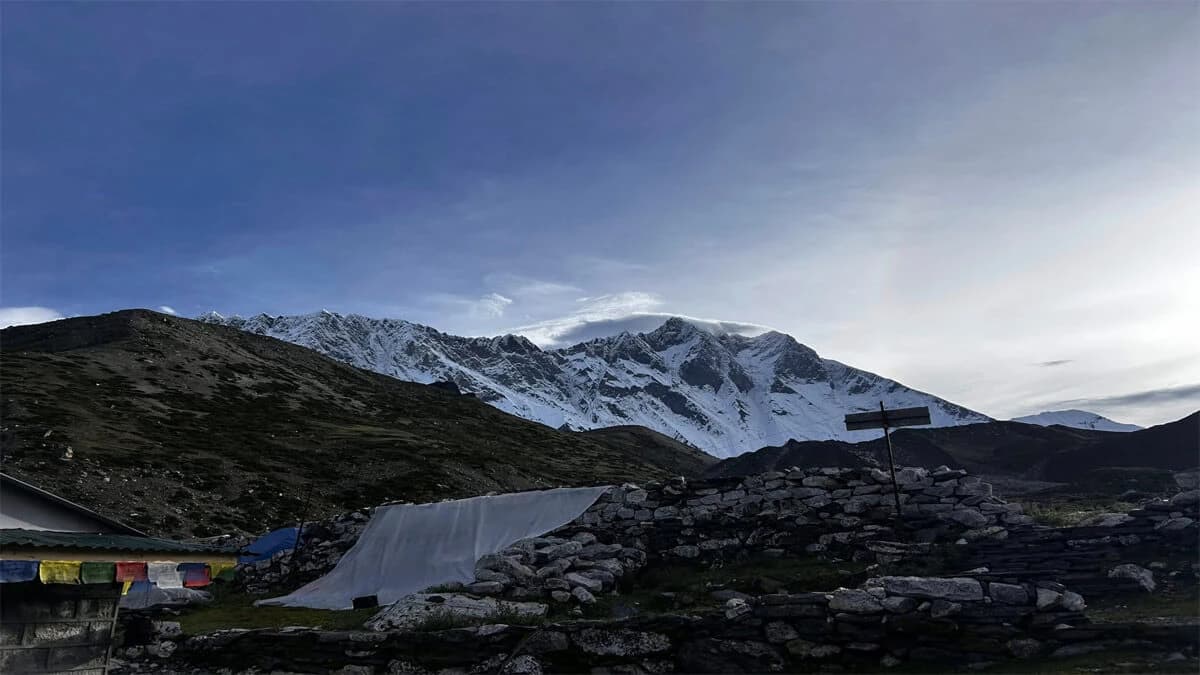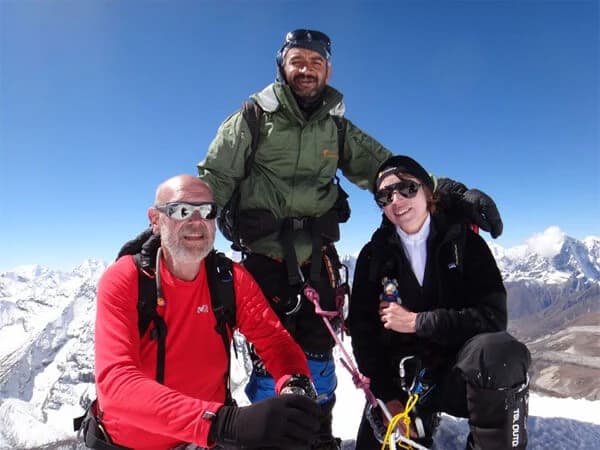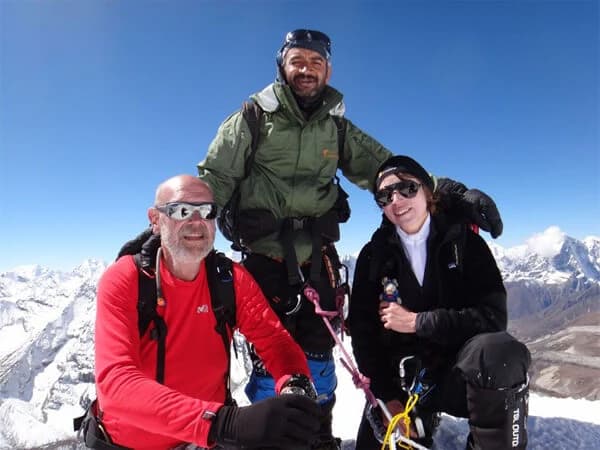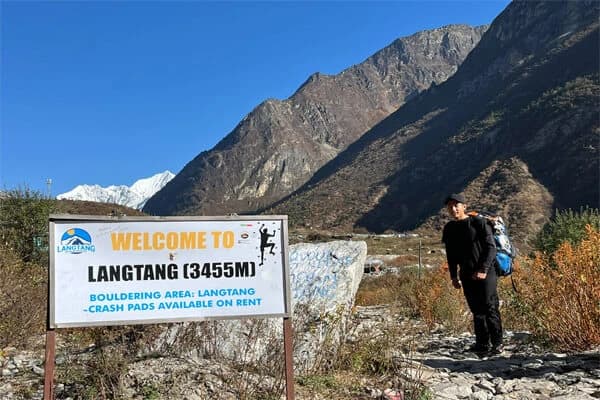The Island Peak Climbing Itinerary provides a wonderful combination of trekking and mountaineering in the Everest region. Trekkers travel from Lukla via Namche Bazaar, Dingboche, and Chhukung to Island Peak Base Camp, with a summit day at 6,189 meters. Itineraries range from 14 to 18 days, with the option to visit Everest Base Camp for a more immersive experience. The climb is moderately difficult, needing enough acclimatization, fitness, and technical skills for the snow and ice sections. Guided support assures safety, cultural knowledge, and logistical convenience, making the Island Peak Climbing Itinerary an enjoyable excursion for both novice and experienced climbers.
Island Peak Climbing itinerary
Island Peak Climbing itinerary is one of the most thrilling excursions plan in Nepal. It is ideal for trekkers who aspire to become mountaineers. Island Peak, also known locally as Imja Tse, rises majestically in the Everest region and resembles an island set against a sea of ice, hence its name. It is classified as a trekking peak, which means it is appropriate for beginners who wish to try climbing above 6,000 meters while being tough enough to provide a true sense of Himalayan adventure.
What distinguishes this climb is that it combines the best of trekking and climbing. You begin your adventure by following the famous Everest Base Camp path via Sherpa communities, suspension bridges, rhododendron forests, and high-altitude scenery. Along the route, you will get the opportunity to acclimatize in popular places like as Namche Bazaar, Tengboche, and Dingboche, all of which provide amazing views of Everest, Lhotse, and Ama Dablam. After several days of trekking, you arrive to Island Peak Base Camp, where you can train and prepare for the summit attempt.
The summit itself is an amazing experience. From the top, you may get a panoramic view of the Himalayas, which comprise some of the world's highest mountains. This accomplishment transforms the trip into not simply a physical struggle but also a deeply satisfying experience.
In this blog, we will walk you through the entire Island Peak Climbing itinerary, discussing daily highlights, preparatory advice, and practical details to help you plan your Himalayan experience.
Island Peak Climb Distance and Elevation
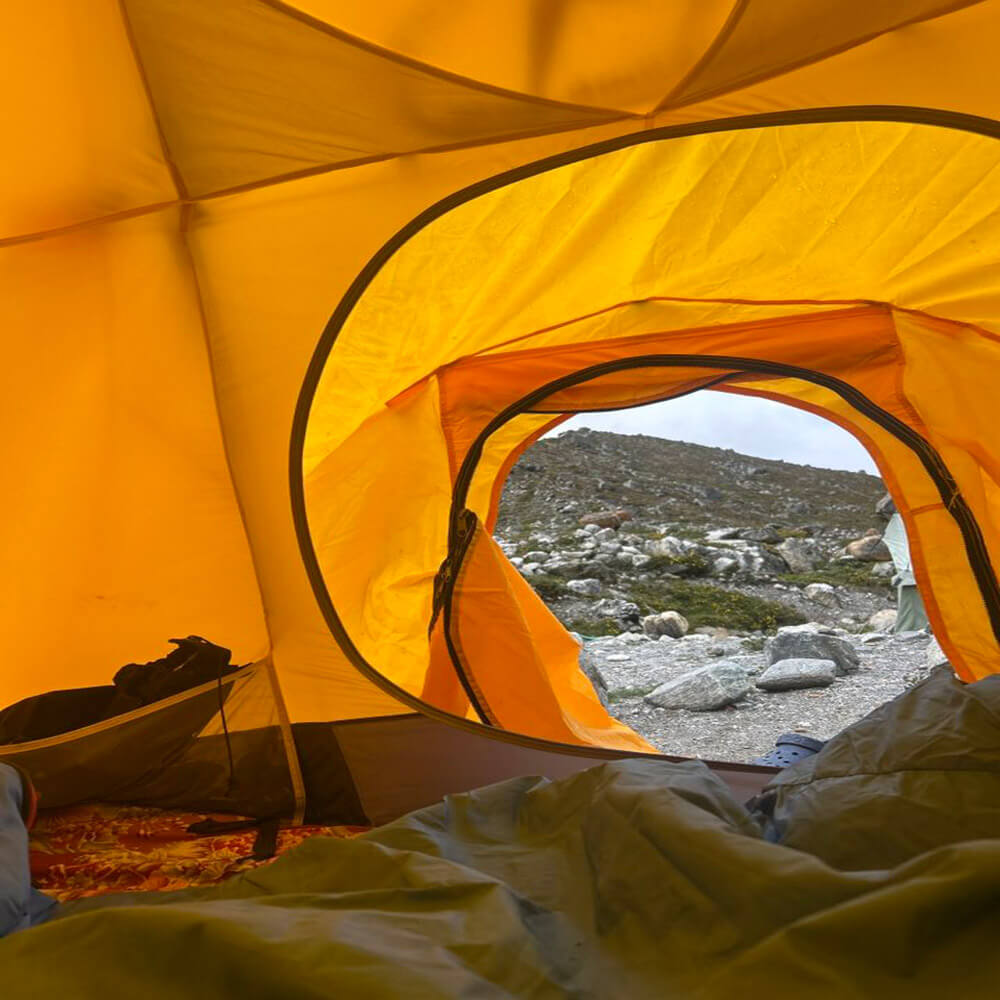
Island Peak, also known as Imja Tse, is one of the most popular climbing peaks of Nepal. It provides an exciting combination of trekking and mountaineering. The climb begins in Lukla and continues through Phakding, Namche Bazaar, Tengboche, Dingboche, and Chhukung before arriving at Island Peak Base Camp. The overall trekking distance from Lukla to Base Camp is about 60-65 kilometers one way, depending on the route and acclimatization variations.
The Island Peak climbingbegins from it's Base Camp, which is roughly 5,100 meters (16,732 feet) high, and ends at the summit, which is 6,189 meters (20,305 feet). This means that climbers gain over 1,000 meters of elevation during the summit push, which frequently necessitates the use of technical climbing equipment like crampons, ice axes, and ropes. The approach to the top consists of snow and ice slopes, crevasse crossings, and high ridges that need both physical fitness and careful navigation.
The whole round-trip distance, including the return trek to Lukla, is approximately 120-130 kilometers, spread out over 14-18 days depending on the schedule. The steady altitude climb promotes adequate acclimatization, lowering the risk of altitude sickness.
Island Peak Climb Duration and Difficulty
Duration of Island Peak Climbing Itinerary
An Island Peak Climbing Itinerary typically lasts 14 to 18 days, depending on the chosen route, pace, and whether trekkers include side visits such as Everest Base Camp or acclimatization treks. A typical 14-day plan focuses on reaching the summit safely while also visiting the Everest region's main sights, such as Lukla, Namche Bazaar, Dingboche, Chhukung and Island Peak Base Camp. A 16-day schedule includes additional acclimatization days at important places, which reduces tiredness and improves safety. Meanwhile, an 18-day plan frequently combines Island Peak climbing with a trek to Everest Base Camp and Kala Patthar, providing a full Everest region adventure.
Daily trekking distances range between 5 and 12 kilometers, with moderate to steep elevation rises. Summit days often begin early, around 2-3 a.m., to ensure climbers reach the summit in good weather and return safely to Base Camp by mid-afternoon.
Difficulty Level of Island Peak Climbing Itinerary
The Island Peak Climbing Itinerary is a moderate to difficult trek with a technical summit. The trekking sections include well-marked routes, gentle elevation gains, and manageable lengths, whereas the summit push is more difficult. Climbers must navigate snow and ice slopes, crevasses, and steep ridges using crampons, ice axes, and fixed ropes. Physical fitness, mental attention, and correct acclimatization are required to handle these conditions.
Despite the hard nature of the climb, Island Peak is popular with beginners wishing to gain expertise in Himalayan mountaineering, as qualified guides give teaching and safety support. Trekkers can enjoy the adrenaline of summiting Island Peak while reducing hazards with proper preparation, equipment, and assistance from our company.
Best Time for Island Peak Climbing
Choosing the best season for Island Peak Climbing is an important element of arranging your vacation. The weather in the Himalayas changes frequently, and the success of your ascent is often dependent on favorable conditions. If you look at an Island Peak climbing route map, you will observe that the track travels through high passes, communities, and glaciers before reaching the summit. Knowing the optimum seasons might help you enjoy your walk and climb safely.
Island Peak Climbing in Spring Season (March to May)
Spring is one of the busiest times for the Island Peak expedition itinerary Nepal. The temperature is warmer than in winter, and the skies are mainly clear. Rhododendrons blossom along the lower pathways, making the trek visually appealing and pleasant. Snow remains at higher altitudes, but it is stable, providing a better climbing surface. This season also provides amazing panoramic views of Mount Everest, Lhotse, Ama Dablam, and Makalu from the summit. Many climbers choose spring because it offers the finest combination of warmth, visibility, and safety.
Island Peak Climbing in Autumn Season (September to November)
Autumn is another great time for climbers. During this time, the monsoon rains have removed dust and pollution from the air, revealing crystal-clear skies. The routes are dry, making it easier to navigate through the communities and high passes shown on the Island Peak climbing route map. The temperatures are moderate, not too hot or too cold, making trekking and climbing more comfortable. Autumn is also culturally rich, with significant Nepali festivals such as Dashain and Tihar taking place at this time, allowing trekkers to experience Sherpa and Hindu traditions.
Island Peak Climbing in Seasons to Avoid.
Winter (December to February) and monsoon season (June to August) are not ideal season for Island Peak climbing. In the winter, heavy snow, intense cold, and ice conditions make the road extremely perilous. During the monsoon, severe rainfall causes landslides, treacherous routes, and poor visibility, making it difficult to follow the Island Peak expedition itinerary in Nepal successfully.
Spring and autumn offer the most reliable climbing conditions. Whether you plan with a group or on your own, scheduling your trip around these dates will increase your chances of success and provide you with unforgettable views of the Himalayan giants.
Physical Fitness and Preparation for Island Peak
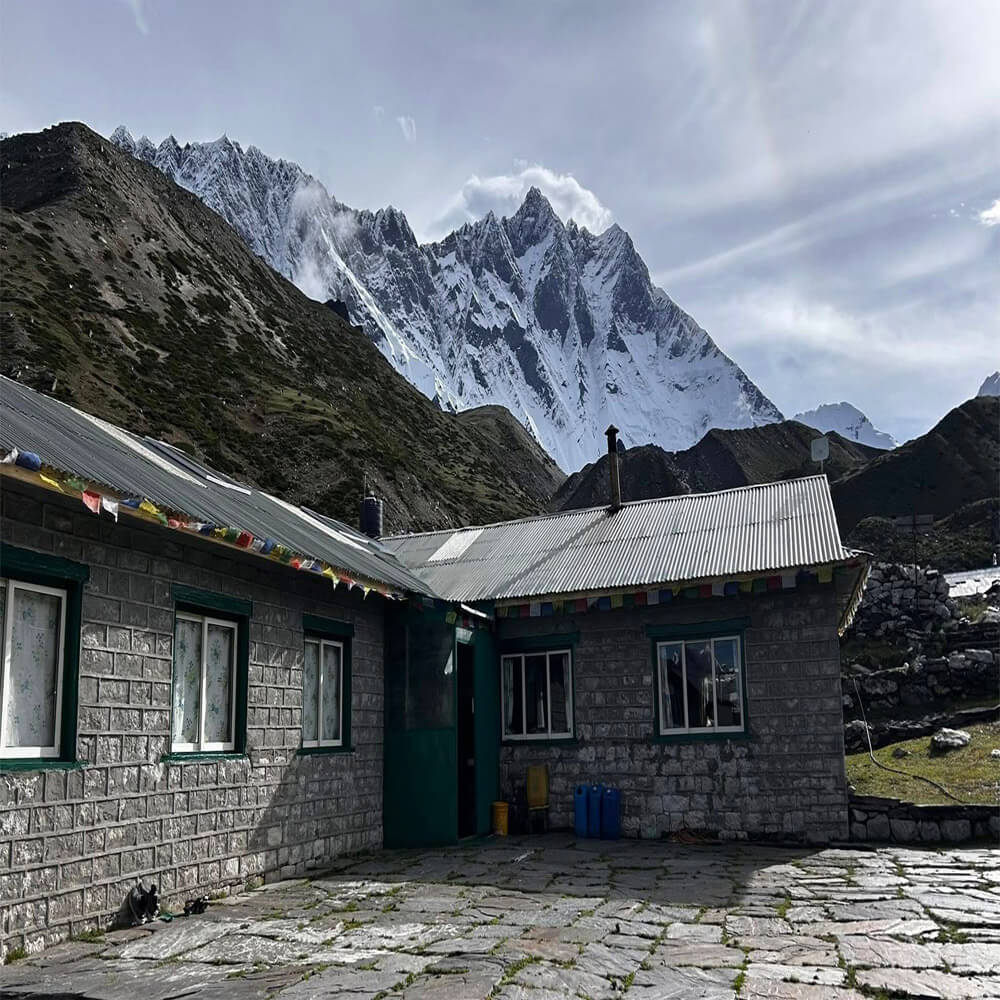
Climbing Island Peak is more than just following a trail; it is about getting your body and mind ready for the adventure. While the peak is frequently referred to as "beginner-friendly," it still demands good fitness, cautious acclimatization, and the proper equipment. This section focuses on the essential components of the Island Peak climb preparation itinerary and the overall Island Peak trekking and climbing plan.
Building Physical Fitness
Island Peak is above 6,000 meters, therefore trekkers should be prepared for long days on steep trails. Before beginning, it is necessary to train for at least three months. Focus on:
- Cardio training, such as jogging, cycling, or swimming, can help you gain stamina.
- Strength training for the legs, core, and shoulders in order to carry a backpack and use climbing equipment.
- Trekking practice on hills with a full pack to simulate trekking conditions.
This preparation ensures that you can trek for 5-7 hours per day while still having enough energy for the summit push.
Acclimatization in the Island Peak Climbing Itinerary
A well-designed Island Peak trekking and climbing plan includes rest days for acclimatization. Climbers spend additional nights on the trek via Namche Bazaar, Dingboche, and Chhukung to allow their bodies to adjust to the thin air. Without sufficient acclimatization, the danger of altitude sickness increases, risking the ascent.
Many routes include side treks, such as trekking adjacent ridges to practice. These little treks prepare your body for higher altitudes while increasing confidence.
Technical Training for the Island Peak Climbing
Island Peak is not just a trekking peak; it requires traversing glaciers, utilizing ropes, and climbing with crampons. Prior to the summit attempt, guides undertake pre-climb training at Island Peak Base Camp. Climbers learn to:
- Use an ice axe and a harness.
- On snow or ice, walk with crampons.
- Climb and descend fixed ropes safely.
Beginners as well can benefit from this training, but they must listen intently and practice.
Packing and Gear Preparation
Your Island Peak climb preparation itinerary is incomplete without the right gear. Warm down jacket, sleeping bag, mountaineering boots, helmet, harness, and climbing equipment are all must-haves. While some gear can be leased in Kathmandu or Namche, personal goods such as boots should be thoroughly broken in before the journey.
Preparation is the link between dream and accomplishment. The Island Peak trekking and climbing plan transforms into a safe and pleasant trip with strong fitness, thorough acclimatization, technical training, and appropriate equipment.
Island Peak Climbing Itinerary Overview
When organizing their journey, many individuals opt for a day by day Island Peak itinerary. Even if you do not go into depth about each day, knowing how the adventure unfolds is beneficial. The climb typically mixes trekking and climbing, which makes it exciting but needs a well-balanced strategy. The overall Island Peak climbing schedule begins in the Everest region and progressively ascends to the top, allowing ample time for acclimatization and preparation.
Starting the Journey in the Everest Region
The tour normally begins with a picturesque flight into Lukla, one of the world's most well-known alpine airstrips. From here, trekkers enter the Everest region, following trails that lead to Everest Base Camp. The trip passes through Sherpa settlements such as Phakding and Namche Bazaar. These early days are not just for walking; they also help your body to gradually adjust to the altitude. The Sherpa culture, monasteries, and mountain scenery make the journey delightful before the climbing begins.
Acclimatization Along the Trail
Acclimatization is a crucial part of the Island Peak climbing schedule. Without correct altitude adjustment, it may be difficult to continue the climb or try the summit. Trekkers typically spend extra time in locations such as Namche Bazaar and Dingboche. These acclimatization pauses consist of short treks to higher vistas during the day and sleeping at lower elevations at night. This progressive strategy helps to avoid altitude sickness and makes the climb safer.
Island Peak Expedition from Chhukung
Following Dingboche, the trail continues to Chhukung, a tiny village that serves as a base for many climbers. The Island Peak expedition from Chhukung is commonly regarded as the final stage of preparation. Trekkers relax, check their gear, and occasionally receive rudimentary climbing instruction from instructors. Chhukung is also surrounded by breathtaking peaks such as Ama Dablam and Lhotse, creating an uplifting environment before the real battle begins.
Moving to Base Camp and Training
Climbers leave Chhukung and travel to Island Peak Base Camp. This is where kids learn and practice using climbing equipment including ropes, crampons, and ice axes. Even for people with limited mountaineering expertise, this training is incredibly beneficial. Spending a night or two at base camp allows the body to rest and psychologically prepare for summit day.
Summit Attempt and Return
The summit push is the high point of the day by day Island Peak schedule. Climbers typically begin early in the morning, following their guide via rocky trails, snow slopes, and, finally, the headwall up to the summit. The vista from the summit of Everest, Makalu, and other Himalayan peaks is breathtaking. After celebrating their accomplishment, climbers return to base camp and begin their journey back through the Everest region.
Overall Flow of the Schedule
The Island Peak climbing schedule skillfully balances trekking days, acclimatization stops, training, and summit attempts. While each trip may alter significantly depending on the company and weather, the basic itinerary remains the same: trek to Everest region villages, acclimatize, prepare in Chhukung, attempt the climb, and return safely. This balanced approach is what makes the climb possible for many adventurers.
Island Peak Climbing Itinerary Customization
Island Peak climbing Itinerary can be customized to meet a variety of fitness levels, durations, and experiences. Trekkers can select between shorter 14-day excursions, slower 16-day itineraries, and longer 18-day expeditions that include Everest Base Camp. Nepal Trekking Routes tailorss Island Peak packages to each traveler's needs, ensuring safe, well-organized, and fully guided experiences.
Island Peak Itinerary 14 Days
The 14-day Island Peak itinerary is suitable for trekkers who have limited time yet want to fully experience the Everest region. The journey starts with a flight from Kathmandu to Lukla, then gradually progresses through Phakding, Namche Bazaar, and Tengboche. To assist prevent altitude sickness, the route includes acclimatization days in Dingboche and Chhukung. The ascent begins at Island Peak Base Camp, where guides provide critical training on ice axes, crampons, and rope procedures. Summit day begins early, usually before daybreak, to allow climbers to safely reach the summit and return to Base Camp. The journey closes with a return to Lukla and a flight back to Kathmandu, providing for a short but satisfying itinerary.
Island Peak Itinerary 16 Days
The Island Peak Climbing 16-day Itinerary program has a little slower pace, allowing travelers more acclimatization and more time to appreciate the scenery and culture. After the normal approach via Lukla, trekkers spend additional days in Namche Bazaar and Dingboche on acclimatization treks. This itinerary frequently includes a side trip to Chhukung Ri, which offers panoramic views of Everest, Lhotse, and Ama Dablam prior to the Island Peak summit attempt. The climbing phase remains unchanged, but the additional days minimize tiredness and promote safety for individuals with less experience at high elevations. Returning by the same route allows for more exploration and photography, resulting in a well-balanced mix of trekking, climbing, and cultural immersion.
Island Peak Itinerary 18 Days with Everest Base Camp (EBC)
The 18-day itinerary offers the ultimate Everest region experience, combining Island Peak climbing with a journey to Everest Base Camp. Starting in Lukla, trekkers take the conventional route through Namche Bazaar, Tengboche, and Dingboche before arriving at Island Peak Base Camp for climbing preparation. After summiting Island Peak, the route continues to Lobuche, Gorak Shep, and Everest Base Camp, with a trek to Kala Patthar for iconic sunrise views of Everest. This plan gives for adequate acclimatization and rest days, resulting in a safer and more immersive vacation. Combining trekking and climbing in one trip provides the best of Everest's features.
Highlights of the Island Peak Climbing Itinerary
Scenic Journey through the Everest Region
The Island Peak trekking route with highlights begins in the heart of the Everest region. Trekkers begin their journey in Lukla, passing through pine trees, rivers, and suspension bridges on their way to famous Sherpa communities. The vibrant prayer flags and warm grins of the people set the tone for the adventure. Along the journey, trekkers will visit Namche Bazaar, the Khumbu's bustling market town, and Tengboche, home to one of the Himalayas' most spiritual monasteries. These locations give great cultural dimension to the adventure, elevating it beyond just a climb.
Acclimatization and Stunning Landscapes
The Island Peak base camp itinerary includes acclimatization days in Namche Bazaar and Dingboche. These stops not only assist trekkers adjust to the altitude, but also allow them to enjoy panoramic mountain vistas. Dingboche, surrounded by fields of stone-walled terraces, has stunning views of Ama Dablam and Lhotse. Chhukung, another acclimatization stop, serves as the gateway to Island Peak, offering close-up views of glaciers and rough terrain.
Island Peak Base Camp Experience
Reaching Island Peak Base Camp is an adventure unto itself. Towering peaks and glaciers provide as a backdrop for the campsite. Climbers receive basic mountaineering instruction, including how to utilize ropes, crampons, and harnesses. The enthusiasm grows as everyone prepares for the summit push. This section of the Island Peak base camp itinerary ensures climbers' confidence and safety before ascending. Nights at base camp frequently contain inspiring stories from guides and fellow trekkers, resulting in an unforgettable sense of friendship.
Summit Day - The Ultimate Reward
Summit Day is the most thrilling highlight. Beginning before daybreak, climbers cross icy slopes and ridges with the assistance of their guides. The final push to the top requires determination but pays off with breathtaking 360-degree views. Trekkers may see Everest, Lhotse, and Nuptse from the summit, as well as the breathtaking Khumbu Glacier scenery. The experience of standing on Island Peak is frequently characterized as a life-changing achievement.
Return Journey with Lasting Memories
Following the climb, the journey back via Namche to Lukla feels lighter, full of pride and success. The return along the Island Peak trekking route with highlights allows trekkers to reflect on their experience, learn more about Sherpa culture, and celebrate their achievement of conquering one of the most iconic trekking peaks of Nepal.
Permits and Costs for Island Peak Climbing
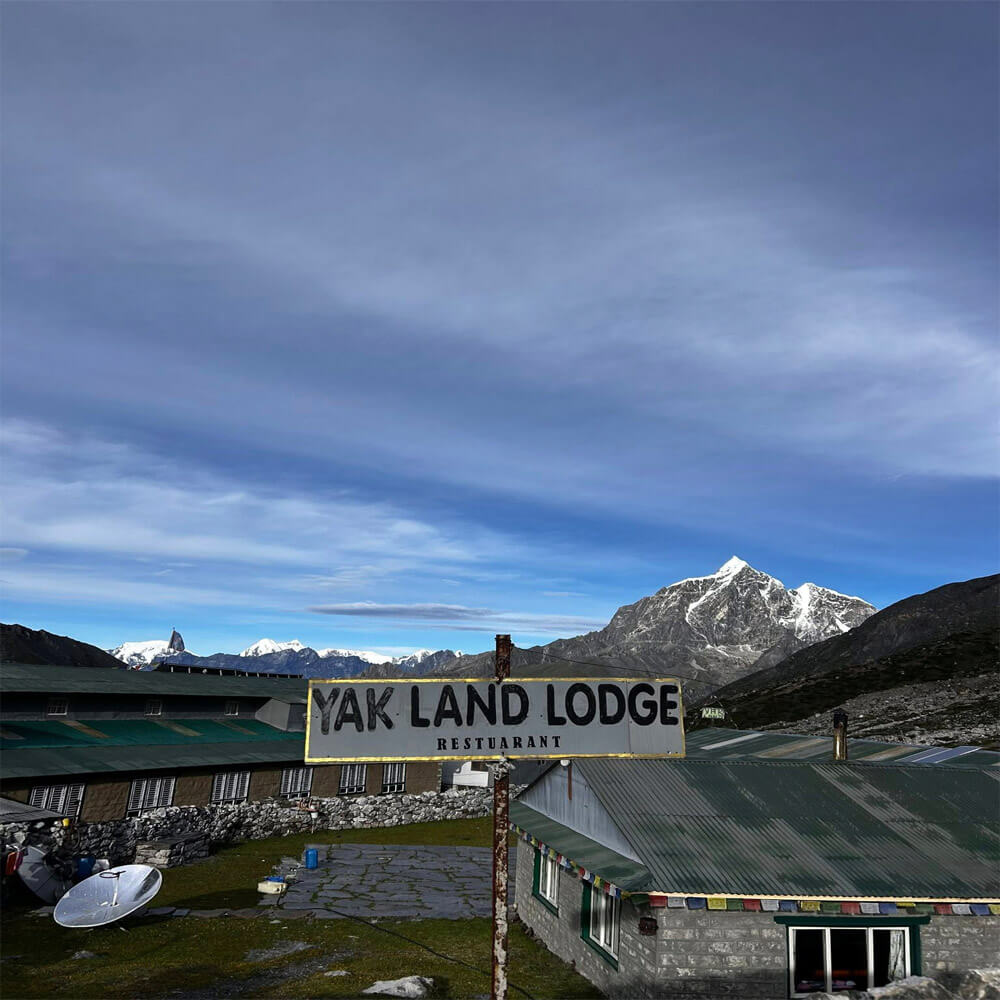
Climbing Island Peak is an amazing adventure, but it takes proper permissions and budgeting. Whether you choose a direct route or combine the climb with the Island Peak via Everest Base Camp trek, having the proper papers and funding is critical.
Required Permits
Island Peak Climbing Permit: This special permit is issued by the Nepal Mountaineering Association (NMA). The cost changes with the season. It is higher in spring and autumn, while it is cheaper in winter and monsoon.
- Sagarmatha National Park Entry Permit: Since Island Peak lies inside the Sagarmatha National Park, trekkers must pay for park entry.
- Khumbu Pasang Lhamu Rural Municipality Permit: This local permit is required for entering the Khumbu region.
- TIMS Card (Trekkers’ Information Management System): Needed for trekking trails in Nepal to ensure safety and record keeping.
Your trekking organization will usually arrange for these permissions as part of the Island Peak climbing package schedule, so you will not have to bother about collecting them yourself.
How much does it Cost for Island Peak Climb
The overall Island Peak Climbing cost varies depending on the route, number of days, and services included. On average, the Island Peak climbing package itinerary costs between USD 1,900 and 2,800 per person. The pricing usually includes:
- Domestic flights (Kathmandu–Lukla–Kathmandu).
- Accommodation in Kathmandu and along the trekking route.
- Meals during trekking and climbing days.
- Permits and park fees.
- Professional guides, climbing Sherpas, and porters.
- Group climbing equipment (ropes, tents, safety gear).
- Pre-climb training at base camp.
Extra personal expenses may include insurance, tips for staff, snacks, or gear rental.
Cost of Island Peak via Everest Base Camp Trek
Many climbers opt to combine their ascent with the traditional Everest Base Camp journey. This longer path aids with acclimatization and provides additional adventure. The cost of a Island Peak via Everest Base Camp trek is typically greater, ranging from USD 3,500-4,500 per person, because it takes longer and includes additional accommodation, food, and guiding services.
The permit application and fee may appear difficult, but everything gets simpler when booked through our agency, Nepal Trekking Routes. A comprehensive Island Peak climbing package itinerary not only includes permits and services, but also assures that your trip is safe, legal, and well-organized.
Safety and Acclimatization on Island Peak Climb
Safety should always come first when selecting a Island Peak climbing itinerary. The trek mixes Everest trekking with a challenging alpine ascent. Proper acclimatization, coaching, and usage of appropriate equipment make the trek safer and more pleasurable.
Importance of Acclimatization Days
Allowing your body adequate time to adjust to high altitude is a critical component of a successful Island Peak climb with acclimatization days. As trekkers ascend above 3,000 meters, the danger of altitude sickness increases. Most trips include rest days at Namche Bazaar and Dingboche before continuing on to higher elevations. These days are not idle; trekkers frequently take short excursions to neighboring vistas, which helps the body adapt gradually. Climbers who follow a well-planned Island Peak climbing itinerary that includes acclimatization stops enhance their stamina, lower the danger of Acute Mountain Sickness (AMS), and feel more confident on summit day.
Role of Experienced Guides and Sherpas
Guides and Sherpa climbing assistants are critical to safety. They understand the terrain, the weather, and the appropriate speed for trekking. On summit day, they assist climbers in using ropes, harnesses, crampons, and ice axes properly. A guided climb not only assures physical safety, but also provides mental support during difficult situations.
Training and Pre-Climb Practice
Most itineraries include a pre-climb training session before arriving at the base of Island Peak. During this lesson, guides show rope skills, fixed line use, and ice or snow safety. This exercise boosts confidence, particularly among first-time climbers.
Safety Gear and Precautions
Carrying the appropriate equipment, such as helmets, harnesses, crampons, and down jackets, is another safety precaution. Personal medications, hydration salts, and energy snacks should also be included on the trek. It is critical to follow the guide's recommendations for pacing, drinking plenty of water, and recognizing early indicators of altitude issues.
A carefully planned Island Peak climbing itinerary with acclimatization days, competent assistance, and suitable equipment ensure both safety and success. Many climbers describe the summit push as difficult yet satisfying, particularly because their journey was aided by an appropriate balance of acclimatization days and competent care.
Frequently Asked Question
What is the best time for Island Peak climbing?
The best seasons are spring (March–May) and autumn (September–November). These periods offer clear skies, stable weather, and ideal trekking conditions. Winter can be cold with snow challenges, and monsoon brings heavy rain and landslide risks.
How long does the Island Peak climbing itinerary take?
Depending on the plan, the itinerary ranges from 14 to 18 days. A 14-day trek focuses on the summit and main highlights, 16 days allow extra acclimatization, and 18 days often combines the climb with Everest Base Camp.
What is the difficulty level of Island Peak?
The trek is moderate to challenging, while the summit climb is technical. It involves snow slopes, crevasses, and steep ridges. Fitness, acclimatization, and proper equipment like crampons and ice axes are essential.
Do I need previous climbing experience?
No prior mountaineering experience is necessary. Island Peak is considered suitable for beginners with trekking experience. Professional guides provide training and support, ensuring safety during the summit push.
What permits are required for Island Peak climbing?
Climbers need an Island Peak climbing permit, a TIMS card, and a Sagarmatha National Park permit. Agencies like Nepal Trekking Routes assist in obtaining all necessary permits and organizing the itinerary, making the process smooth and hassle-free.
Conclusion: Island Peak Climbing itinerary
Island Peak climbing is more than just reaching the summit; it is a trip that combines adventure, culture, and personal development. The walk takes you past bustling Sherpa settlements, Buddhist monasteries, and beautiful mountain views, making every step significant. The climb itself tests your endurance and abilities, but the ultimate result is an unforgettable vista of the Himalayas and a strong sense of accomplishment.
It is frequently regarded as the ideal peak for individuals looking to take their trekking experience to the next level and try mountaineering for the first time. Nepal Trekking Routes can help you design a safe, well-organized, and exciting Island Peak adventure.

